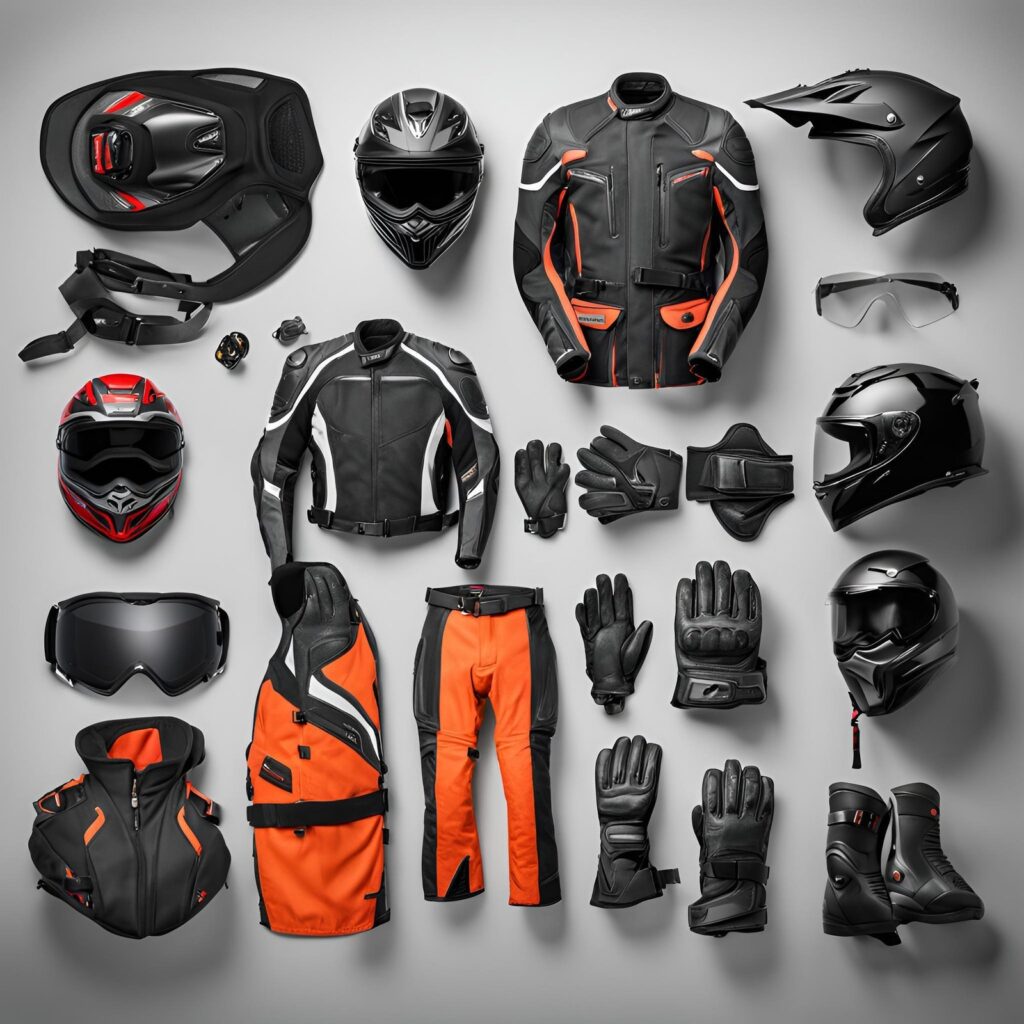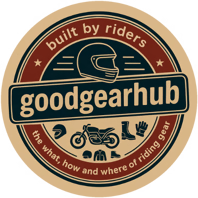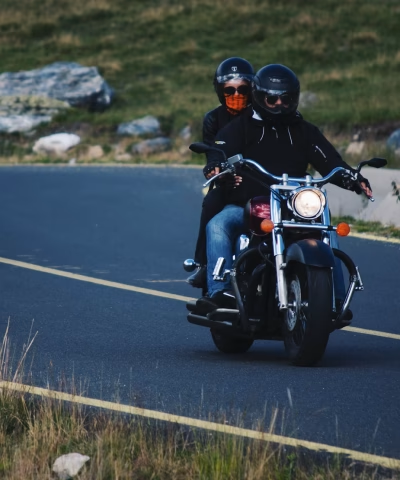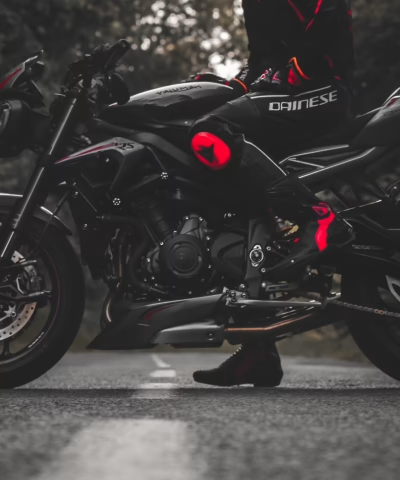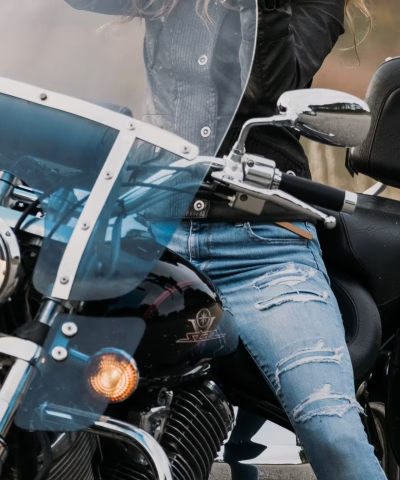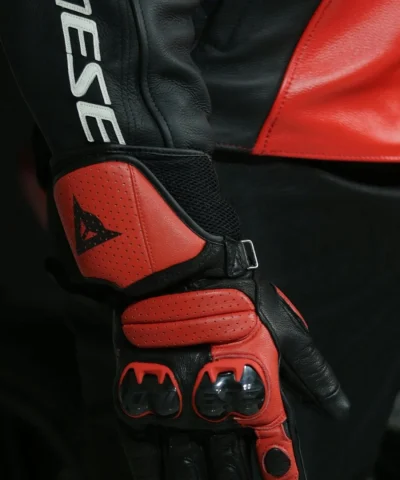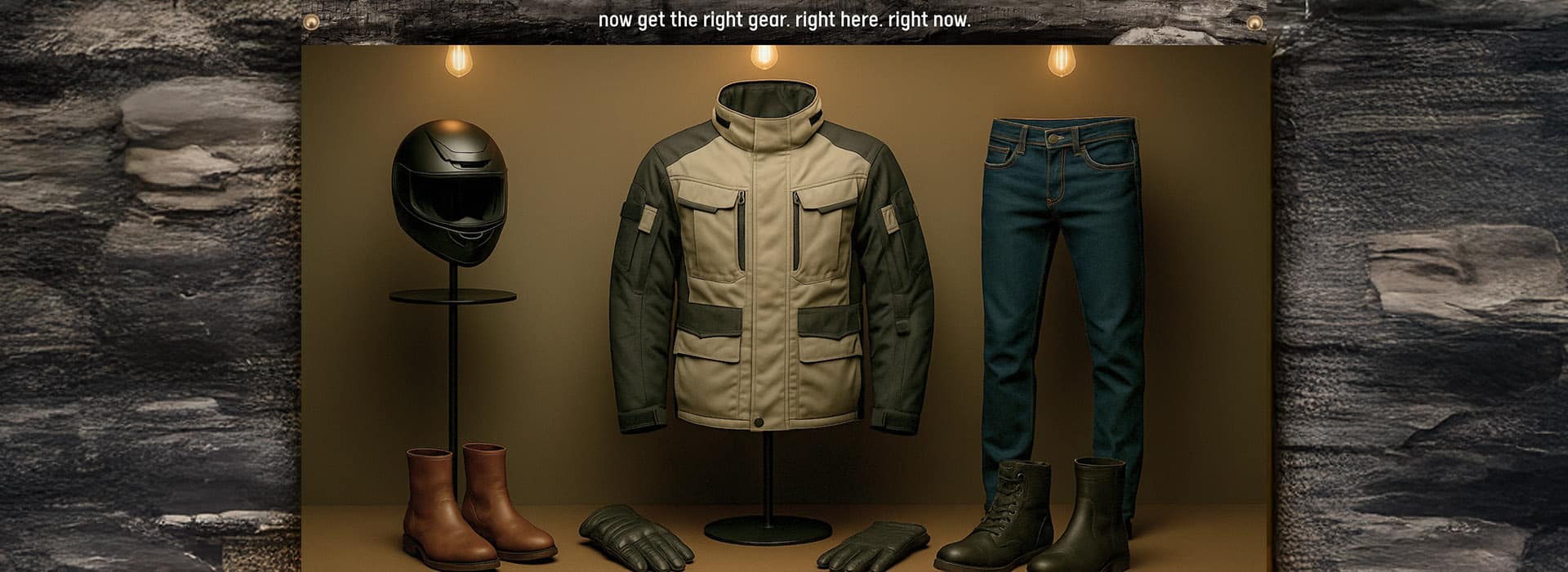
Motorcycle Riding Gear.
Start with the GearFinder Tool to pinpoint exactly what you need — then use the guide, built from 20 years and 2M km of riding, to choose the right motorcycle riding gar for your style, terrain, and trips.
Here is the link to the gear finder tool – https://goodgearhub.com/gear-finder-tool/
Not sure which motorcycle riding gear is right for you? Scroll down for our expert guide — built from 20 years and 2M km of riding — to choose your perfect gear.
Motorcycle Riding Gear — The Complete Buying Guide
Motorcycle riding gear isn’t about looking good; it’s about coming home in one piece and enjoying every kilometer in between. Motorcycle Riding Gear protects you from impact, abrasion, weather, fatigue, and distraction. Done right, it also improves control, endurance, and confidence. Backed by 20 years and 2M km of riding, this guide lays out exactly what to buy, how to fit it, and how to maintain it — across helmets, jackets, gloves, jeans & pants, and boots.
How to Use This Page
Start with the GearFinder Tool to lock your ride type, climate, budget, and safety priorities.
Use the sections below to choose types, features, and fit in each category.
Finish with the checklists and pro tips before you buy.
Why You Should Never Ride Without Motorcycle Riding Gear
Impact protection reduces the severity of crashes that would otherwise end your season.
Abrasion resistance prevents skin loss in slides that shred casual clothing in under a second.
Weather control stops hypothermia, heat exhaustion, and distraction.
Fit and ergonomics reduce fatigue, numbness, and delayed reactions.
Visibility upgrades make you seen sooner by distracted drivers.
The Five Elements of Motorcycle Riding Gear
Motorcycle Riding Helmets
Types
Full-face: best overall protection for street and touring.
Modular (flip-up): touring convenience with good protection.
Open-face (¾): city use; no chin protection.
Dual-sport/ADV: visor peak, wide viewport, goggle-compatible.
Off-road/MX: light, airy, for dirt only.
What to Look For
Certification: ECE 22.06 (preferred), Snell, or DOT.
Shell: fiberglass or carbon for strength-to-weight; polycarbonate for value.
EPS liner: multi-density for progressive impact absorption.
Fit and retention: snug all around; D-ring or secure micrometric buckle.
Ventilation: chin, brow, and exhaust vents you can operate with gloves.
Visor system: Pinlock-ready, quick release, wide field of view.
Weight and aero: balanced to reduce neck strain and buffeting.
Fit & Sizing
Measure head circumference above eyebrows; check brand chart.
Try for 10–15 minutes; no hot spots; cheeks should feel snug.
Helmet should not roll off or rotate easily when strapped.
Pro Tips
Replace after 5 years or any impact.
Keep a clear visor for night and a tinted one for day.
Add a chin curtain and breath guard for cold, wet rides.
Motorcycle Riding Jackets
Types
Textile touring: waterproof liners, vents, pockets for all-season use.
Adventure/ADV: rugged textiles, large vents, armor coverage for mixed terrain.
Racing/track: leather, CE Level 2 armor, external sliders, snug fit.
Urban/commuter: lighter textiles or leather with slim armor.
Mesh summer: maximum airflow for hot climates.
What to Look For
CE armor: shoulders, elbows, and back (upgrade to Level 2).
Abrasion zones: heavier fabric or leather at impact points.
Weather: removable thermal and waterproof liners; large vents.
Fit system: waist, cuff, and bicep adjusters to hold armor in place.
Visibility: reflective elements or high-vis panels.
Fit & Sizing
Check reach on the bike; sleeves must cover wrists when leaned forward.
Ensure armor stays on joints while seated and standing.
Leave space for mid-layer if you ride in winter.
Pro Tips
Most jackets ship with soft back pads; upgrade to a certified back protector.
Add chest armor if the jacket allows.
Use base layers to manage sweat instead of unzipping safety.
Motorcycle Riding Gloves
Types
Touring: gauntlet length, waterproof or 3-season options.
ADV: balanced protection and ventilation for mixed terrain.
Racing: full-gauntlet leather, hard knuckle armor, palm sliders.
Urban/short-cuff: easy on/off for city rides.
Winter/insulated: thermal lining and waterproof membranes.
What to Look For
CE certification: impact and abrasion tested.
Knuckle armor: hard or advanced foam protection.
Palm sliders: reduce scaphoid injuries in slides.
Materials: leather for abrasion; textile for airflow and weather.
Closure: secure wrist strap that cannot slip off.
Fit & Sizing
Snug without pinching; no extra fingertip slack.
Full bar reach without pulling the webbing or lifting the palm.
Wrist strap should tighten firmly over the radius bone.
Pro Tips
Carry a dry pair on tours; wet gloves ruin grip and morale.
Gauntlet gloves keep water from funneling into sleeves.
Touchscreen fingertips save time on navigation stops.
Motorcycle Jeans & Pants
Types
Riding jeans: denim with Kevlar/aramid panels and CE knee/hip armor.
Textile touring pants: waterproof, vented, armor at knees/hips.
Adventure/ADV pants: heavy-duty textiles, cargo pockets, high abrasion zones.
Leather pants: track-focused abrasion resistance.
Overpants: quick on/off over work clothes.
What to Look For
CE armor: adjustable knee and hip pockets for alignment.
Abrasion: Kevlar, Cordura, or leather at slide zones.
Venting: thigh vents or mesh panels for heat.
Weather: waterproof membranes for rain seasons.
Fit: articulated knees, stretch zones for long hours.
Fit & Sizing
Measure waist and inseam with riding base layers.
Sit on the bike; armor must cover knees in riding position.
Check boot interface: tapered or boot-cut as needed.
Pro Tips
Regular denim fails fast in slides; never rely on it.
Keep spare knee pads to swap if the originals wear out.
Carry compact rain overpants for surprise storms.
Motorcycle Riding Boots
Types
Touring: tall shaft, waterproof options, all-day comfort.
Adventure/ADV: maximum protection, aggressive tread, tall profiles.
Racing/track: torsion control, hard cups, replaceable sliders.
Urban/short: walkable, discreet armor for city use.
Enduro/MX: maximum shin and ankle bracing for dirt.
What to Look For
CE rating: ankle, heel, and shin protection.
Sole: grip on wet pegs and rigidity for support.
Waterproofing: membranes that keep feet dry without cooking them.
Closures: buckles/BOA/zippers that won’t pop open.
Shift pad: reinforcement for long-term durability.
Fit & Sizing
Leave 1–1.2 cm toe gap; snug heel and ankle with no lateral slop.
Test with your riding socks; walk, flex, shift on the bike.
Ensure the shaft height matches your pants’ cuff style.
Pro Tips
Don’t size up; boots break in, loose boots break you.
Use tall, moisture-wicking socks to prevent hotspots.
Never dry boots with high heat; stuff and air dry.
Seasonal and Climate Setup
Hot climate: mesh jacket, vented gloves, vented pants, breathable boots, Pinlock visor.
Wet climate: laminated or membrane jackets and pants, gauntlet gloves, waterproof boots.
Cold climate: thermal mid-layer, windproof outer, insulated gloves, neck gaiter.
Mixed climate: removable liners, zip vents, packable rain layers.
Layering Strategy That Works
Base layer: moisture-wicking top and bottom to keep skin dry.
Mid layer: fleece or light insulated layer for cold days.
Outer layer: armored jacket and pants for protection.
Rain layer: laminated shells or over-gear when storms hit.
Common Mistakes Riders Make
Buying for looks, not certification and fit.
Wearing casual denim and sneakers on “short rides.”
Choosing oversized jackets and pants “for comfort.”
Skipping back protectors and chest armor.
Ignoring ventilation and then riding unzipped.
Neglecting maintenance so gear fails early.
Budget Tiers — What You Actually Get
Entry (value): certified basics, fewer vents, heavier weight, solid protection if fitted right.
Mid (sweet spot): better armor, better materials, real waterproofing, balanced weight.
Premium (specialized): top armor, laminated shells, carbon/fiberglass lids, light weight.
Maintenance and Replacement Intervals
Helmets: replace every 5 years or any impact; wash liners; lube visor pivots.
Jackets: clean seasonally; re-waterproof textiles; condition leather.
Gloves: wipe after rides; condition leather; replace if palms abrade.
Pants: cold wash as directed; check seams and armor pockets.
Boots: clean and dry after rain; condition leather; inspect soles and buckles.
Buying Online vs In-Store — Do Both Right
Online: measure accurately, read fit notes, check return policy, order two sizes if allowed.
In-store: try in riding stance, check armor alignment, wear base layers, test zips and vents.
Finalize: choose the one you will wear every ride, not the “prettiest” one.
Quick Recap — Motorcycle Riding Gear Checklist
Helmet: certified, snug, clear Pinlock-ready visor.
Jacket: CE armor, abrasion zones, vents or liners.
Gloves: CE, knuckle armor, palm sliders, secure wrist.
Pants: CE knees/hips, reinforced fabric, climate fit.
Boots: CE ankle/shin, rigid sole, waterproof option.
Layers: base for sweat, mid for cold, shell for impact.
Visibility: reflective accents or bright colors.
Fit: check on the bike, not just in a mirror.
Maintenance: clean, condition, reproof, replace on time.
GoodGear ProTips (From 2M km of Riding)
If armor shifts off-joint in riding position, the garment is the wrong size.
A laminated waterproof jacket beats a drop-in liner when rain is frequent.
Two-glove setup (summer + wet/cold) solves 90% of hand comfort issues.
Touring happiness = vented jacket + packable rain shell + base layers.
Never compromise boots and gloves; hands and ankles are first to hit.
Final Ride-Out Note
Use the GearFinder Tool to get a tailored shortlist for your ride type, climate, and budget.
Pick certified Motorcycle Riding Gear that fits correctly and you’ll actually wear.
Maintain it, and it will take care of you when it matters most.
Till affiliate links are not in place consider our go to places
Trusted Gear Links
USA
EU/UK
https://www.sportsbikeshop.co.uk
https://www.championhelmets.com
SPECIALIST GEAR SITES
https://www.lonerider-motorcycle.com
